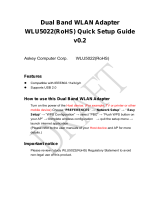
ODYSSEY – STM32MP157C
Reference Guide
www.seeed.cc Rev APage 8
FCC Regulatory Compliance Information
This device complies with Part 15 of the FCC Rules. Operation is subject to the following two conditions: (1) this
device may not cause harmful interference, and (2) this device must accept any interference received, including
interference that may cause undesired operation.
Please notice that if the FCC identification number is not visible when the module is installed inside another
device, then the outside of the device into which the module is installed must also display a label referring to the
enclosed module. This exterior label can use wording such as the following: “Contains FCC ID:XXXXX” any similar
wording that expresses the same meaning may be used.
This equipment complies with FCC radiation exposure limits set forth for an uncontrolled environment. This
equipment should be installed and operated with a minimum distance of 20cm between the radiator & your body.
This transmitter must not be co-located or operating in conjunction with any other antenna or transmitter.
The module is limited to OEM installation ONLY. The OEM integrator is responsible for ensuring that the end-user
has no manual instruction to remove or install module.
antenna configurations.
The OEM integrator is responsible for ensuring that the host product which is installed and operating with the
module is in compliant with Part 15B unintentional Radiator requirements, please note that For a Class B digital
device or peripheral, the instructions furnished the user manual of the end-user product shall include the
following or similar statement, placed in a prominent location in the text of the manual:
Note: This equipment has been tested and found to comply with the limits for a Class B digital device, pursuant to
part 15 of the FCC Rules. These limits are designed to provide reasonable protection against harmful interference
in a residential installation. This equipment generates, uses and can radiate radio frequency energy and, if not
installed and used in accordance with the instructions, may cause harmful interference to radio communications.
However, there is no guarantee that interference will not occur in a particular installation. If this equipment does
cause harmful interference to radio or television reception, which can be determined by turning the equipment
off and on, the user is encouraged to try to correct the interference by one or more of the following measures:
• Reorient or relocate the receiving antenna.
• Increase the separation between the equipment and receiver.
• Connect the equipment into an outlet on a circuit different from that to which the receiver is connected.
• Consult the dealer or an experienced radio/TV technician for help.
The module is limited to installation in mobile application; A separate approval is required for all other operating
configurations, including portable configurations with respect to Part 2.1093 and difference
End Device Labelling
RF Exposure Compliance
Installation Notice
FCC Part 15B Compliance of End Device
Warning: changes or modifications not expressly approved by the party responsible for compliance could void the
user’s authority to operate the equipment.










